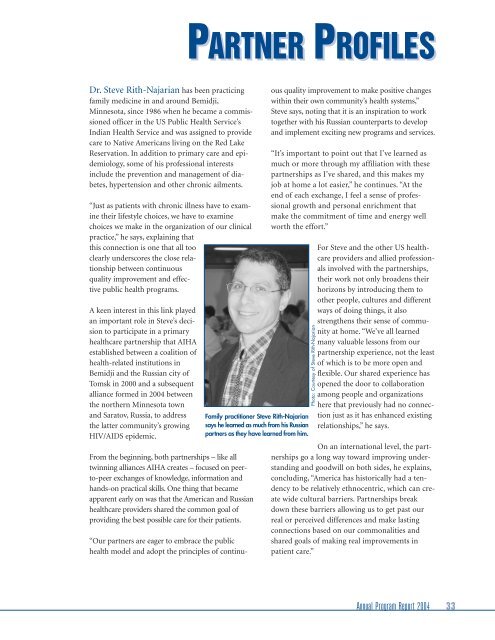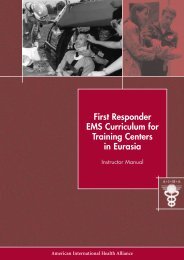Annual Program Report 2004 - American International Health Alliance
Annual Program Report 2004 - American International Health Alliance
Annual Program Report 2004 - American International Health Alliance
Create successful ePaper yourself
Turn your PDF publications into a flip-book with our unique Google optimized e-Paper software.
PARTNER PROFILES<br />
Dr. Steve Rith-Najarian has been practicing<br />
family medicine in and around Bemidji,<br />
Minnesota, since 1986 when he became a commissioned<br />
officer in the US Public <strong>Health</strong> Service’s<br />
Indian <strong>Health</strong> Service and was assigned to provide<br />
care to Native <strong>American</strong>s living on the Red Lake<br />
Reservation. In addition to primary care and epidemiology,<br />
some of his professional interests<br />
include the prevention and management of diabetes,<br />
hypertension and other chronic ailments.<br />
“Just as patients with chronic illness have to examine<br />
their lifestyle choices, we have to examine<br />
choices we make in the organization of our clinical<br />
practice,” he says, explaining that<br />
this connection is one that all too<br />
clearly underscores the close relationship<br />
between continuous<br />
quality improvement and effective<br />
public health programs.<br />
A keen interest in this link played<br />
an important role in Steve’s decision<br />
to participate in a primary<br />
healthcare partnership that AIHA<br />
established between a coalition of<br />
health-related institutions in<br />
Bemidji and the Russian city of<br />
Tomsk in 2000 and a subsequent<br />
alliance formed in <strong>2004</strong> between<br />
the northern Minnesota town<br />
and Saratov, Russia, to address<br />
the latter community’s growing<br />
HIV/AIDS epidemic.<br />
From the beginning, both partnerships – like all<br />
twinning alliances AIHA creates – focused on peerto-peer<br />
exchanges of knowledge, information and<br />
hands-on practical skills. One thing that became<br />
apparent early on was that the <strong>American</strong> and Russian<br />
healthcare providers shared the common goal of<br />
providing the best possible care for their patients.<br />
Family practitioner Steve Rith-Najarian<br />
says he learned as much from his Russian<br />
partners as they have learned from him.<br />
“Our partners are eager to embrace the public<br />
health model and adopt the principles of continuous<br />
quality improvement to make positive changes<br />
within their own community’s health systems,”<br />
Steve says, noting that it is an inspiration to work<br />
together with his Russian counterparts to develop<br />
and implement exciting new programs and services.<br />
“It’s important to point out that I’ve learned as<br />
much or more through my affiliation with these<br />
partnerships as I’ve shared, and this makes my<br />
job at home a lot easier,” he continues. “At the<br />
end of each exchange, I feel a sense of professional<br />
growth and personal enrichment that<br />
make the commitment of time and energy well<br />
worth the effort.”<br />
Photo: Courtesy of Steve Rith-Najarian<br />
For Steve and the other US healthcare<br />
providers and allied professionals<br />
involved with the partnerships,<br />
their work not only broadens their<br />
horizons by introducing them to<br />
other people, cultures and different<br />
ways of doing things, it also<br />
strengthens their sense of community<br />
at home. “We’ve all learned<br />
many valuable lessons from our<br />
partnership experience, not the least<br />
of which is to be more open and<br />
flexible. Our shared experience has<br />
opened the door to collaboration<br />
among people and organizations<br />
here that previously had no connection<br />
just as it has enhanced existing<br />
relationships,” he says.<br />
On an international level, the partnerships<br />
go a long way toward improving understanding<br />
and goodwill on both sides, he explains,<br />
concluding, “America has historically had a tendency<br />
to be relatively ethnocentric, which can create<br />
wide cultural barriers. Partnerships break<br />
down these barriers allowing us to get past our<br />
real or perceived differences and make lasting<br />
connections based on our commonalities and<br />
shared goals of making real improvements in<br />
patient care.”<br />
<strong>Annual</strong> <strong>Program</strong> <strong>Report</strong> <strong>2004</strong> 33
















